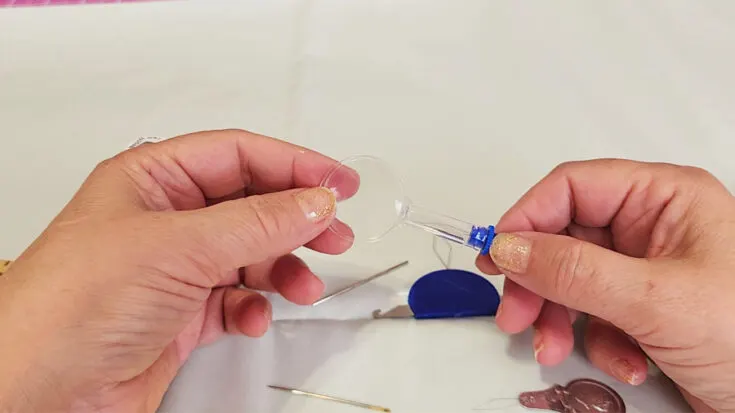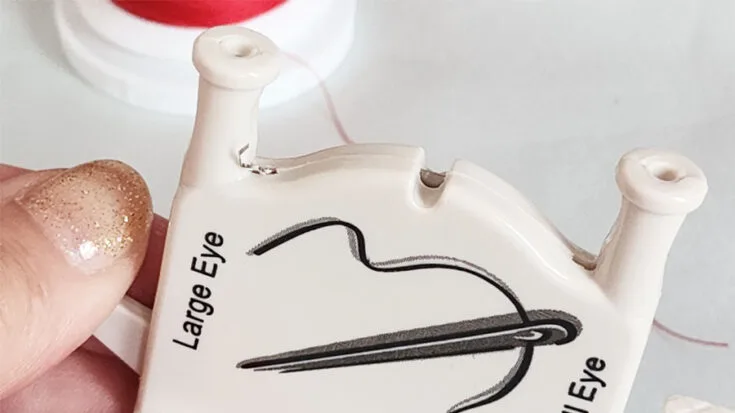When the woman heard that I always use a needle threader to thread my sewing machine needle, her eyes lit up. “Oh, I used to sew all the time, ” she said. “But then my eyes got bad and my hands got shaky to even thread my sewing machine. It became so frustrating to try, that I had to give it up. I sure do miss it though!” One of the neatest things I’ve ever done was help this sweet woman rediscover her love for sewing.
With a simple, inexpensive gadget called a needle threader, she was able to once again use her sewing machine. If she had known how to use a needle threader for sewing machine needles, she wouldn’t have wasted so much time missing out on expressing herself creatively with needle and thread.
Don’t make the mistake of thinking that you can’t sew if you can’t thread a needle! There are so many ways to get around this issue, and I will fill you in on needle threaders so you can sew without this problem!
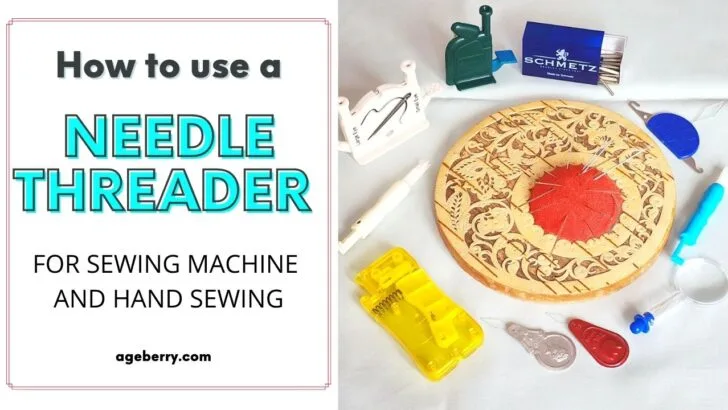
What Is a Needle Threader?
A needle threader is an inexpensive tool that will help you thread a needle easily even if your vision is poor or your hands are a bit shaky. There are many different kinds of needle threaders, but each one will assist you in threading your needle with no frustration, well, almost no frustration, because some needle threaders might frustrate you as well. You can use a needle threader for a sewing machine or for hand sewing.
There are several different types of needle threaders available, but most work in a similar way. The threader typically consists of a thin wire or hook attached to a handle. To use it, you simply insert the wire or hook through the eye of the needle and then thread the end of the thread through the wire. Finally, you pull the wire back through the eye of the needle, and the thread should be pulled along with it.
Why Use a Needle Threader Tool?
A needle threading tool can make threading your needles easy. Instead of snipping the thread, wetting the end, and trying to jab the thread into the eye of the needle, you can use this tool to make the process simple and quick.
Most of us don’t like to think about getting older, but as we age, certain things that were simple when we were younger can become much more difficult. One of the things that starts getting tricky is eyesight. Suddenly, the words on a page get blurrier and small things like the eyes of our sewing needles get smaller!
Actually, the real problem is that vision can be less reliable as we all get older. Even with the assistance of glasses or a magnifier, this simple, basic part of sewing can become so frustrating that, like my friend, you may be tempted to stop sewing altogether!
Another person may struggle with threading a needle because their hands are unsteady. In this world of computers and cell phones, many people have issues with their hands and fingers. These issues can cause the hands of even younger people to shake.
If you struggle with hand tremors or vision issues, a needle threader tool can help you keep on sewing. Even if you just find the process of threading a needle annoying, a needle threader will make this part of sewing a non-issue. In past years, people who couldn’t thread a needle either had to give up sewing or find someone to help them with this task. But with the help of a needle threader tool, you can keep sewing as long as you wish.
One of the main advantages of using a needle threader is that it can save time and frustration. Threading a needle can be a difficult and time-consuming process, especially if you are working with a very fine thread and needle with a small eye. With a needle threader, however, you can quickly and easily (most of the time) thread your needle in just a few seconds, allowing you to get back to your sewing project without delay.
Another benefit of using a needle threader is that it can help to reduce eye strain and fatigue. When you are struggling to thread a needle, you may find yourself squinting and straining to see the tiny eye of the needle. By using a needle threader, you can avoid this strain and discomfort, making it easier to work for longer periods of time.
In any case, a good needle threader should always be on hand for those moments that call for some extra help when you’re trying to finish a sewing project.
Before talking about the needle threaders I have to mention the importance of having very good lighting of your work area (thank you, Bonnie!). I have previously written about lighting (Sewing room lighting ideas) but it does deserve mentioning again. When it comes to lighting your work area, save your eyes! And possibly your fingers😀!
Note: Some of the links on this page are affiliate links. This means I will receive a commission if you order a product through one of my links. I only recommend products I believe in and use myself.
Types of Needle Threaders for Hand Sewing
When it comes to sewing, it’s important to have the right tools on hand. Two types of threaders that can be particularly useful are those designed for traditional hand sewing needles and those designed for sewing machine needles. The reason for this is that the two types of needles have different requirements for threading.
Now, let’s delve into a detailed discussion of needle threaders specifically designed for hand sewing needles.
There are several different types of threaders available, each with its own unique features and benefits. Some are designed to be very simple and straightforward, while others are more complex and may offer additional functionality.
Manual Needle Threaders for Hand Sewing
Manual needle threaders for hand sewing are fairly simple and straightforward. They consist of a wire loop or hook connected to a handle or sometimes, a pressed metal tab. You slip the wire or hook through the eye of the needle, put the thread through the wire loop or the hook, and then pull the wire or hook back through the needle’s eye. And in a snap, your needle is threaded!
Many people are only familiar with the basic, cheap, metal needle threader that consists of a wire loop and a pressed metal tab. I always have a bunch of them and use them all the time. They break easily but they usually have a very thin wire that goes into the smallest needle eye without any problem.
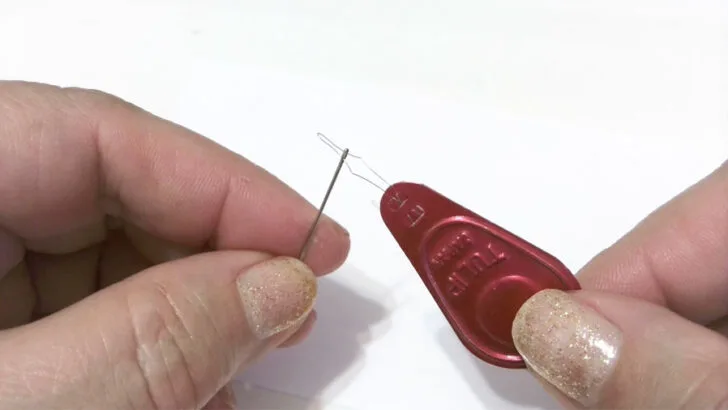
However, there are many others. You can find a retractable one with an LED light attached to it and a thread cutter built-in like this Dritz needle threader.
- Retractable threader protects the wire when not in use
- Bright LED light activates when threader is exposed
- Finger grips provide stability and comfort
- Built-in thread cutter cuts thread to desired length
- Lanyard hole at base of threader for inserting cord or string
You can find needle threaders with a magnifier.
The added benefit of this tool is the magnifying lens, which offers extra visibility to locate the eye of the needle and ensure that threading it correctly won’t be so difficult.
Despite having one myself, I don't like to use it. I tried to use it but found that I was struggling more than usual.
While I had both the needle and threader in my hands there was hardly any room for maneuvering – not enough to focus on keeping the magnifier and thread steady at the same time.
You can buy needle threaders with a plastic or wooden handle. You can even get one in sturdy metal.
And some needle threaders have funny shapes: flowers, butterflies, hummingbirds, pows, etc. They are lightweight and easy to store, sturdy, and not easy to break.
30 Pieces Needles Threaders with Clear Box Durable Sewing Needle Threader for Hand Sewing and Needle Threaders for Embroidery(Random Colors)
Dritz 270 Hummingbird Needle Threader
Simple Threader for Hand Sewing, Small Eye Needles Threaders, Easy to Use, Crafts Sewing Tool
Recently, I’ve noticed an array of fish-shaped needle threaders appearing on Amazon. They look cute and quirky.
Manual needle threaders work great on all sizes of needles – from quilting to beading – effectively streamlining your next project.
Automatic Needle Threaders for Hand Sewing
In today’s society, many things work at the push of a button, and needle threaders are no different. Automatic needle threaders are gadgets that can thread the needle by just pressing a button or flipping a lever.
With one kind of needle threader, you will insert the needle with the eye poking into the hole in the gadget.
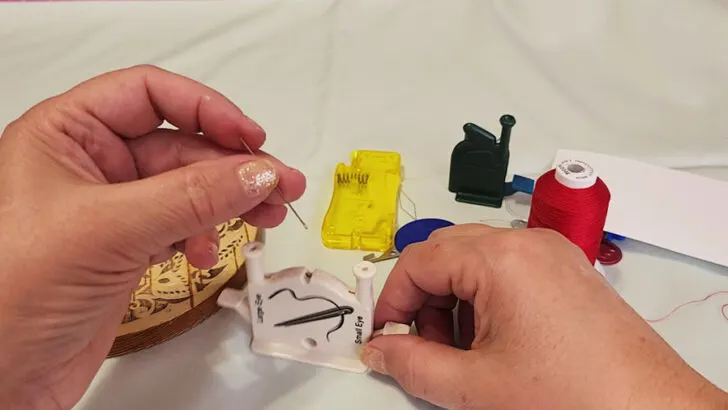
The thread is placed into a notch and then you press and release a button. The thread is pushed through a hole in the threader, and you can pull it through.
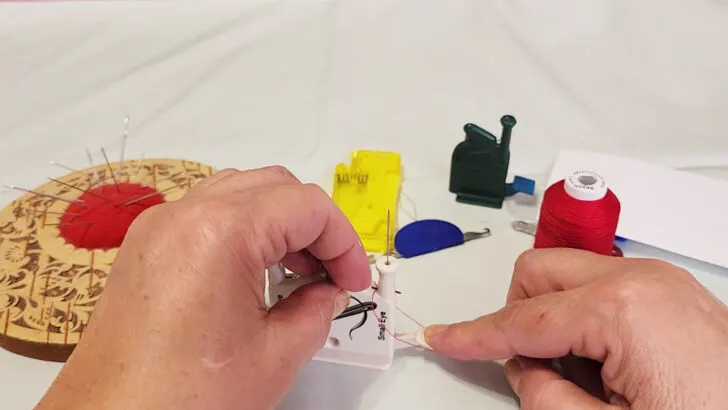
Then, when you remove the needle from the threader, it is threaded.
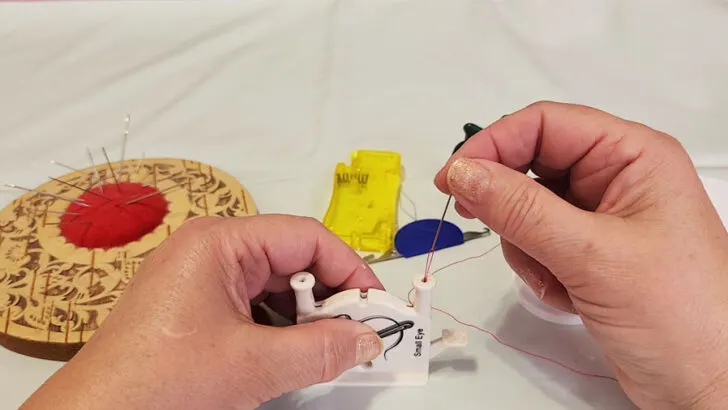
Clover Ultimate Needle Threader
The most popular needle threader of this type is Clover Ultimate Needle Threader.
These nifty needle threaders are suited for hand sewing needles. You just place the needle into the hole with the eye pointed down.
Lay the thread across the notch and hold it slightly taut. Then press the button and release it. The needle can be lifted from the device and should be threaded.
For average needles, this threader works well. However, if you use very small needles, some people report that they have problems with the threader working every time.
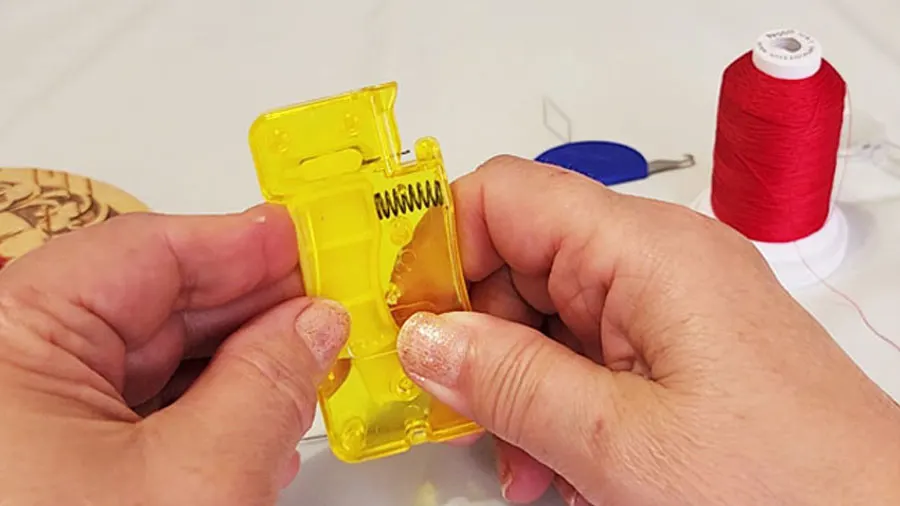
Another kind of automatic needle threader works slightly differently. You place the needle's eye into the device. Then you'll press a button, holding it down.
A hook will protrude from the threader and you will loop the thread around the hook. You’ll release the button and it will pull the thread loop through the eye of the needle. You'll then pull the needle from the device and it will be threaded.
Understanding the Drawbacks of Needle Threaders
While needle threaders can be a useful tool for hand sewing, there are some cons that sewists should be aware of before deciding to use them. Here are some potential problems with needle threaders and some tips for choosing the best one for your needs.
One of the main issues with needle threaders is that they can be difficult to use for very thin needles with small eyes. If the wire or hook on the needle threader is too thick, it may not fit through the eye of the needle, making it impossible to thread the needle.
This can be incredibly frustrating, as a primary benefit of using a needle threader is exactly for relatively small eyes.
Another potential issue with needle threaders is that they can be flimsy and prone to breaking. If the wire or hook is not sturdy enough, it may become bent or broken after just a few uses.
This can be especially problematic if you rely on your needle threader for your sewing projects, as you may need to constantly replace it. For example, the automatic needle threader I described above got broken very quickly - the wire became bent.
That being said, there are some needle threaders that are more effective than others, and choosing the right one can make a big difference in your hand sewing experience.
Types of Needle Threaders for Sewing Machines
Sewing machine needles have a slightly different design that requires a different type of threader.
Manual Needle Threaders for Sewing Machines
Dritz makes one that features a tool for inserting the needle on one end and a threader on the other end. This gadget is very inexpensive and incredibly easy to use. No, you do not need a degree in engineering to figure out how to make this device thread your sewing machine needle! It's super easy!
These instructions are for the Dritz needle threader for your sewing machine
- The threader has a horizontal slot and a vertical one. Hold the threader with the hook on the top. Run the thread through the horizontal slot from right to left.
- Then, put the sewing machine needle in the vertical slot and gently press the threader toward the back of the machine.
- Slide the threader down the needle, pressing gently, and when you get to the eye of the needle, a small metal post will press the thread through the eye of the needle, creating a small loop.
- Slide the threader down the needle until it is free.
- You can then use the hook on the top of the needle threader to pull the loop of thread completely through the needle’s eye.
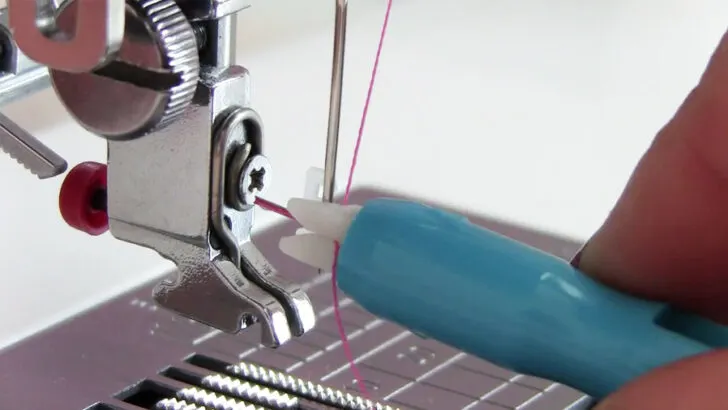
Some people complain that the threader breaks easily. I am not sure why it happens. To me the threader works just fine, I have had it for 5 years already. Of course, you have to be very careful with it – it has really small parts. Or maybe it’s the brand that matters – mine is from Dritz and I know this company makes awesome sewing tools.
I save myself a lot of frustration by having one of these threaders near my serger because serger needles are awkward to thread. This inexpensive tool makes my life easier.
If you want, you can use any of the wired manual sewing needle threaders for your sewing machine. Simply place the wire through the eye of the needle, run your thread through the loop, and pull the wire back out of the machine. Your needle will then be perfectly threaded with no headaches or hassles!
Automatic Built-in Needle Threaders for Sewing Machines
Some sewing machines have an automatic needle threader built into the machine.
A built-in threader is a nifty feature found on many modern sewing machines that can make threading your needle a breeze.
So, how does a built-in threader work? Essentially, it consists of a small hook or wire that is used to guide the thread through the eye of the needle.
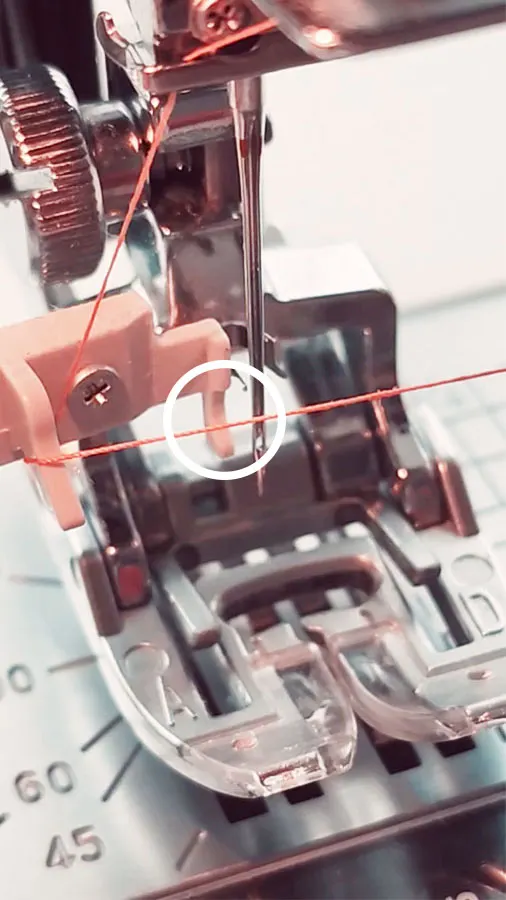
To use a built-in threader, you’ll typically begin by pulling out the machine’s needle and lowering the presser foot. Next, you’ll engage the threader, which will position the hook or wire in the perfect spot to guide the thread through the eye of the needle.
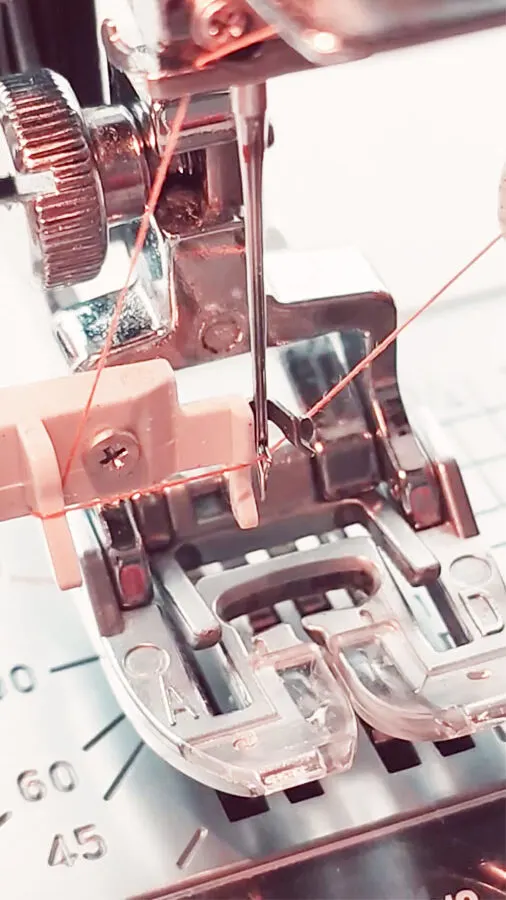
Pull the thread down and under the hook or wire, and then release it so that it can be pulled through the eye of the needle.
The exact steps involved in using a built-in threader can vary somewhat depending on the specific make and model of your sewing machine. Some machines have very straightforward threaders that can be engaged with the push of a button, while others may require a bit more finesse to get the hook or wire in just the right position.
Despite these differences, the basic concept behind a built-in threader remains the same.
Not all machines come equipped with this feature, so you may need to invest in a newer or higher-end machine to take advantage of it. Additionally, some sewists find that the hook or wire on their machine’s threader can become bent or misaligned over time, which can make it less effective at threading the needle.
If your sewing machine has a needle threader on it, you should read the manual to make sure that you know how to use it.
Sewing Machines With an Automatic Needle Threader
This very affordable Janome sewing machine is packed with smart features that make projects easier than ever. With a built-in needle threader, presser foot lift and auto-declutch bobbin winder, it ensures convenience and speed while sewing.
In addition, this machine includes 200 built-in stitches, a 7mm stitch width as well as 7 one-step buttonholes – perfect for achieving those intricate sewing techniques. Plus, the included extension table and 1/4" foot make this the great choice for quilters looking for extra project space.
With so much style and power packed into this machine, you can complete your projects with confidence - making it the go-to choice for sewists.
If you’re an avid sewer, then this Janome machine is a great choice - with its 23 built-in stitches such as stretch stitches, decorative stitches and a one-step buttonhole feature, it offers all the necessary tools to create something beautiful.
The adjustable foot pressure lets you tackle thicker fabrics with ease and the drop feed is great feature for quilters. There's a built-in needle threader that takes away much of the hassle out of getting ready to start stitching.
The machine will be safe and secure while not in use thanks to its hard cover machine storage piece. All in all, the Janome Sewist 725S is well equipped for any sewing task.
If you are looking for a versatile and easy-to-use machine that combines both sewing and embroidery functions, then the Brother 2-in-1 sewing and 4x4 embroidery machine is perfect for you.
With built-in automatic needle threader, 103 built-in sewing stitches to choose from as well as 81 exciting embroidery designs, there is no limit to what you can create with this machine.
Additionally, extra design options are available through the USB port. Crafting projects are made easier with quick change sewing feet, customizable speed controls and drop feed for free-motion sewing.
This Singer machine is loaded with impressive features that make sewing projects quick and easy. With 203 stitch applications viewable on the LCD screen, you can select the perfect style with just the press of a button.
There are six different buttonhole styles to choose from - you're sure to find one ideal for your project. Plus, with its built-in needle threader, you can thread the needle's eye in no time at all.
Constructed with a robust metal frame, this machine offers longevity and reliability, while its removable storage compartment gives you access to the free arm so you can easily work on cuffs and sleeves.
Automatic Needle Threader Troubleshooting
The Threader Won’t Pull The Thread Through
If you are struggling with the automatic needle threader on your sewing machine and it isn’t working, there are a few things that you can do. First, make sure that your sewing machine needle is not bent and is properly installed. If the alignment of the needle threader and the needle is incorrect, it will not work.
Second, make sure that the machine is properly set up. If your threader is designed to work only when the presser foot is down, check that. Also, check that nothing else is interfering, like if the buttonhole attachment is in the wrong position or the needle isn’t in the wrong position. Go back and check every little thing to ensure that your machine is set up correctly for the threader to work.
Next, double check that your threader is designed to work with that particular needle size. Sometimes threaders don’t do well with smaller needles. This is something to discover in your manual.
Finally, examine the threader hook to see if it has somehow gotten bent. You can gently bend it back if this is the case.
The Threader Pulls The Thread Through But The Thread Is Frayed
Again, if this happens, check your threader hook to ensure that it isn’t bent. This could cause it to catch only a portion of the thread. Second, don’t use your automatic threader on heavy or metallic threads. You could be asking for headaches. Just thread these kinds of threads by hand.
Overall, needle threaders are a simple and effective tool that can make sewing much easier and more enjoyable. Whether you are an experienced sewer or a beginner, a needle threader can help to save time, reduce eye strain, and make your sewing projects more enjoyable. With so many different types of needle threaders available, it is easy to find one that will work best for your specific needs and preferences.
Did you find this tutorial helpful? If so, save this pin (see below) on your sewing board so you can come to this tutorial later when you need this information on needle threaders for sewing machines and hand sewing, and follow me on Pinterest for more tips, tutorials, and inspiration!
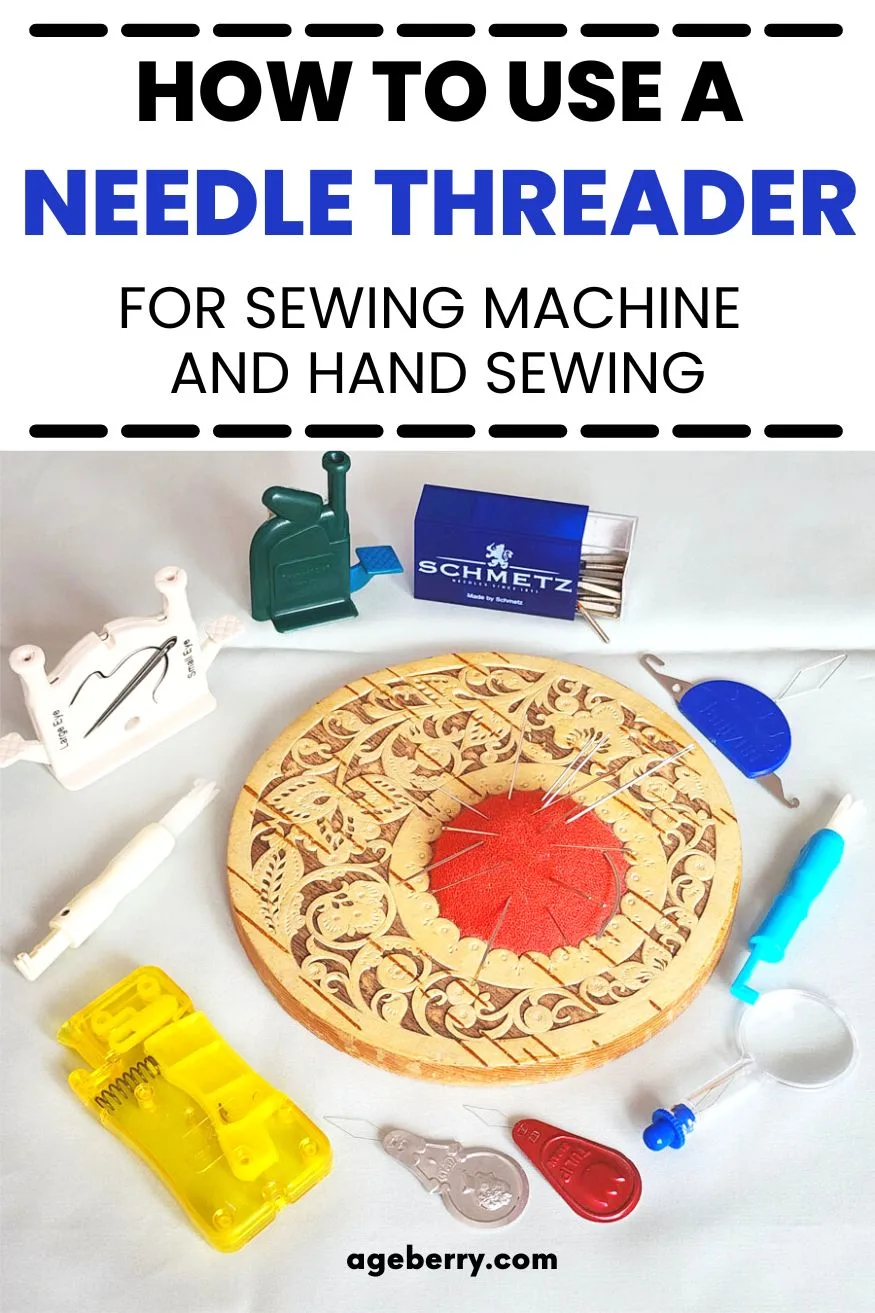
latest posts
- Adorable DIY Needle Book | Easy Tutorial for Beginners
- Master the Seam Ripper: Your Ultimate Guide to Precision Stitch Removal
- Think You Know Zippers? This Installation Guide Might Surprise You
- Why Does Your Seam Ripper Have a Red Ball? Discover Its Purpose!
- Topstitching Troubles? This Simple Trick Will Turn It Around Instantly!
- How to Sew Shirring: A Step-by-Step Guide to Elastic Thread Gathering
- Are Self-Threading Needles Really Useful?
- Amazon Spring Sale: Best Choices
- Elevate Your Prom Look: A Guide to 10 Neckline Choices (2024)


